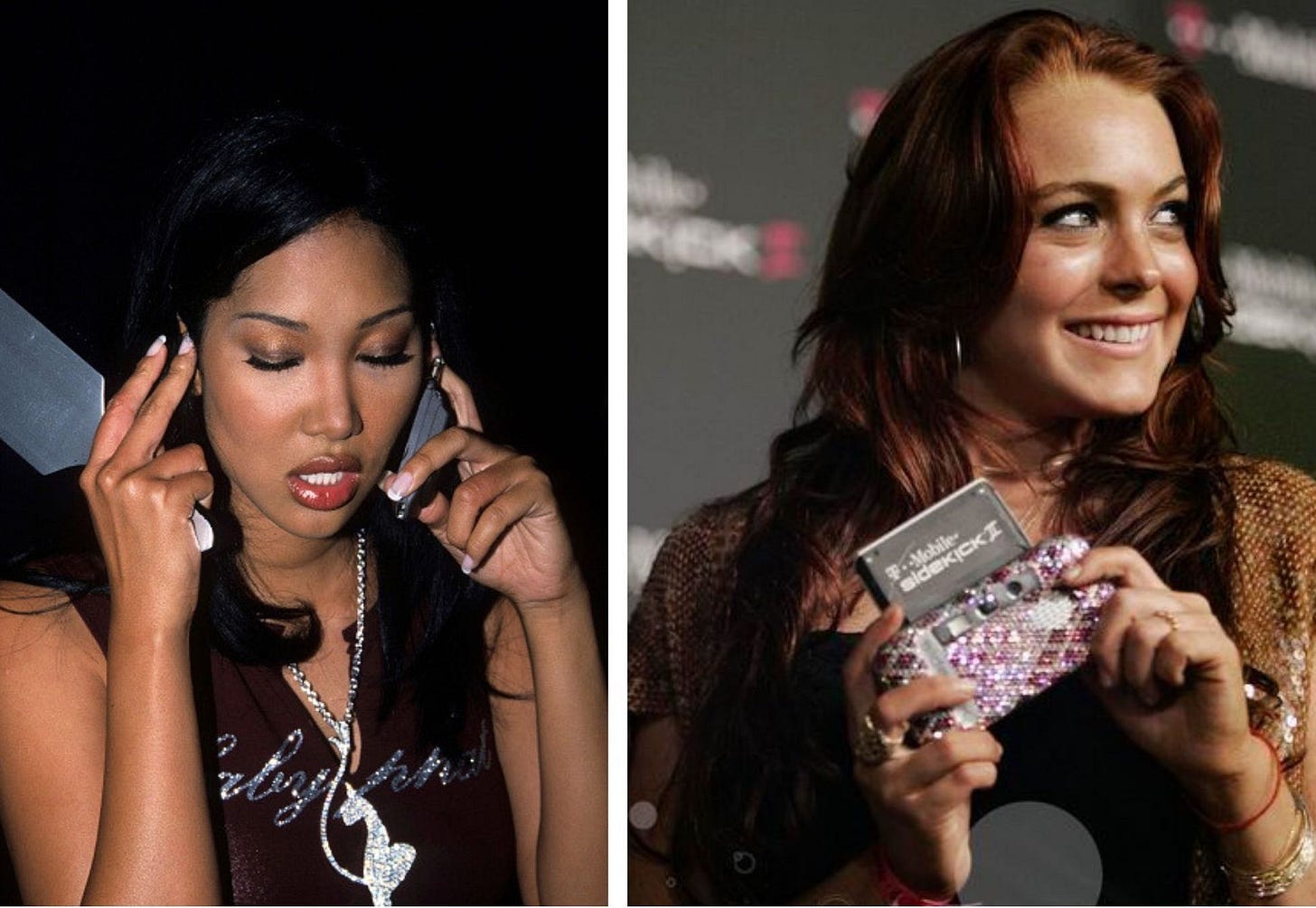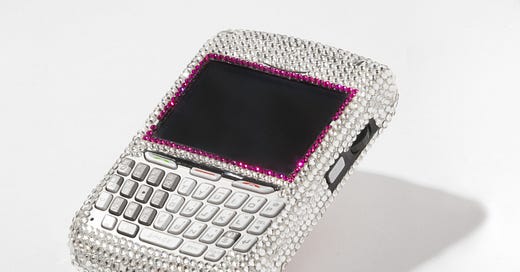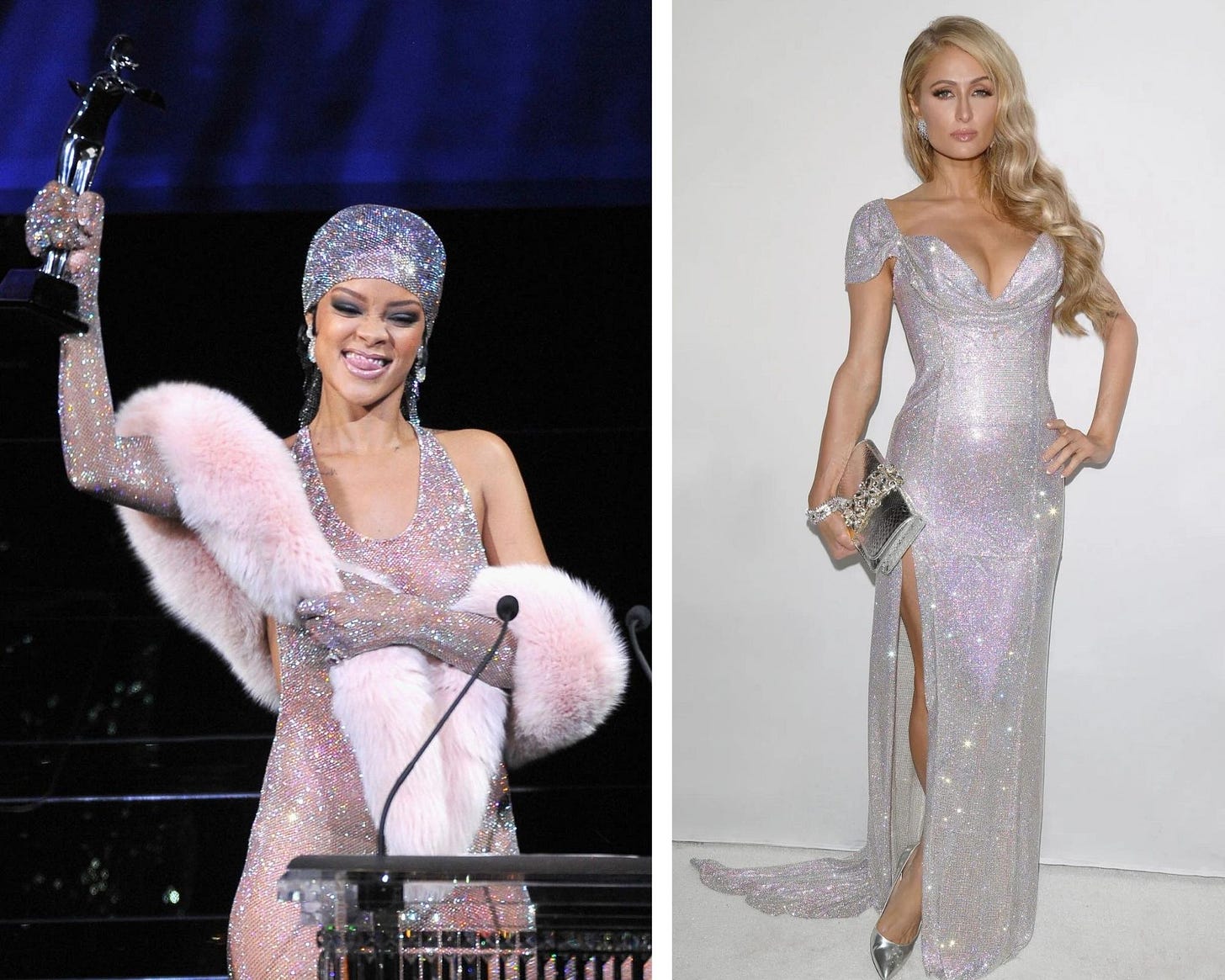rhinestones & the art of bedazzling
on Swarovski crystals, the classism of "good taste", & the value of hobbies
Do you remember these commercials?
In the 2000s, our TVs wanted us to know that the BeDazzler was BACK baby! Rhinestones were everywhere – on baby tees, bandanas, and phone cases. Jennifer Love Hewitt was even vajazzling.
Bedazzled clothing and accessories remained in the world of the low-cost casual, coinciding with the rise in fast fashion. They were always, essentially, tacky, even when they were on trend, and have only become more so now that fashion has moved on.

Or, to be more accurate, moved on from that particular type of rhinestone.
There are essentially two different classes of rhinestone: glass and plastic. It’s plastic rhinestones that have become passé, their glass counterparts never fully going out of style.
Inspired by quartz pebbles once found on the banks of the Rhine River (thus the name), the classiest of rhinestones are cut and polished pieces of leaded glass, also known as crystal. In the 1890s, Daniel Swarovski designed an electric machine that could cut the stones more accurately and cost-effectively than doing so by hand, and set up a factory in the Austrian Alps. Swarovski crystals imitate naturally occurring gemstones, with the goal of creating “a diamond for every woman.”
Swarovski crystals have a tentative relationship with taste. They’re always teetering on the brink of being too much – too cheap, too sparkly, used too excessively. But their resemblance to actual diamonds has led to their widespread use by designers and celebrities. Paris Hilton’s “million dollar dress”, created by August Getty Atelier and worn to the 2017 Hollywood Beauty Awards, featured over 500,000 Swarovski crystals. Rihanna’s iconic (though more controversial) Adam Selman naked dress, created for the 2014 CFDA fashion awards, was adorned with over 230,000 Swarovski crystals. Swarovski even sponsored the event. While their crystals might always be too cheap to satisfy the tastes of the oldest old money rich, Swarovski as a brand have effectively cemented their place in the world of fashion.
The other type of rhinestones, however, have not. Plastic rhinestones – made from either acrylic or resin – are cheap, brightly colored, come in a variety of shapes, and bear essentially no resemblance to precious stones. A heart shaped acrylic gem is not trying to convince you it’s a diamond. It’s just pink.
In the late 1970’s, Ron Popeil and Herman Brickman, creators of such fine infomercial products as the Veg-O-Matic, invented the Ronco Rhinestone and Stud Setter, which would soon be renamed the BeDazzler. Sold via TV and marketed to crafty adult women and children alike, the mass market success of the BeDazzler effectively and permanently sank the acrylic rhinestone to the level of bad taste. With the BeDazzler, affixing rhinestones to clothes became widely accessible, cheap, and safe for children. (No hot glue or sewing needles were needed.)
There are two refrains that the arbiters of taste love using to demean low art: “it looks cheap” and “a child could make that.” In the case of a bedazzled t-shirt, both could now be true. A kid could make it, and it was cheap.

"Good taste" is all about class. The rich decide what counts, and they choose what is available only to them: items that are expensive, in high demand and low supply. Often this means things that are complicated to manufacture, the products of skilled human labor that cannot be replicated by machine. Paris Hilton’s “million dollar” dress took a team of six artists three months to make. Rihanna’s naked dress employed a team of twenty. It was not just the cost of materials that made these garments so expensive, but the labor of a team whose names are never mentioned anywhere near the red carpet.
The stones used in both of their dresses are also essentially colorless. While the sheer amount of embellishment pushes the envelope of good taste, the lack of color keeps these garments in the realm of the chic.
A home-bedazzled garment, however, begs to be over the top. There is no hiding the cheapness of the materials used, so why not embrace the bright colors, create gaudy patterns, attract attention?
The whole ethos behind expecting good taste from people is that if someone is gauche enough to be poor, they should at least have the good manners to be quiet about it. They should do their best to emulate the styles of the rich, and hide the evidence of where they have failed. This is the sin of the BeDazzler. Acrylic rhinestones are not trying to look like diamonds. They aren’t even trying to look like Swarovski crystals. They look like plastic. They look cheap. And people slap them on clothes and parade them around, because they’re fun and they’re colorful, and who really gives a fuck if the upper echelon finds them tacky?
I like them. I think they’re pretty. I glued some to a plastic spoon and taped the spoon to my wall where there was a blank space. Why not? It makes me laugh.
The best thing about bedazzling is that it’s never going to satisfy a person of good taste. I’m not going to make high art with these supplies, so I’m free to make whatever I want. I can let go of perfectionism and put pieces of plastic where I think they look good. When I’m not trying to impress anyone with what I’m making, I’m finally free to enjoy the making itself. It’s fun. It’s a hobby. What with capitalism destroying all of our lives, it’s easy to forget the value of making something for its own sake, not to sell.
A BeDazzler itself is not necessary to bedazzle. My preferred method is a combination of hot glue and Gem-Tac. But the BeDazzler brought us both an incredible verb to use for the affixing of rhinestones, and ignited our imaginations with the possibilities to do so. Any of us can put rhinestones on anything! Even if we don’t want to do it ourselves, we can buy a rhinestone-encrusted shirt at Walmart for twenty bucks.
A BeDazzler, if you can find one in stock anywhere, is $34.99. A bag of rhinestones is $16.99 at Michaels and a hot glue gun is only $2.99 – or a dollar more if you want it in pink (I did). The materials are cheap, the process is easy, and the results are wonderfully hideous. If you want to make something a little bit tackier and more colorful, that is a very approachable goal.
Go forth and bedazzle.
xoxo
Franny 💋





